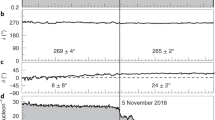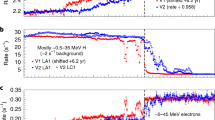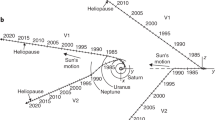Abstract
FROM the measurements registered by Explorer VI in the outer Van Allen radiation belt, C. Y. Fan, P. Mayer and J. A. Simpson1 succeeded in determining the number of particles which, in their longitudinal motion between two magnetic mirrors, cross the equator with a given pitch angle. In the polar diagram (number of particles versus equatorial pitch angle, χe) obtained by those authors a maximum exists for the equatorial pitch χe = 35°. This maximum has a sort of dynamical stability, because it is restored after a magnetic storm. In fact the authors observed a perturbation of the magnetic field, which shifted the maximum from 35° to 48°, but the value χe = 35° was resumed in spite of the fact that the number of electrons with a given velocity v was changed by a factor about 3.8.
This is a preview of subscription content, access via your institution
Access options
Subscribe to this journal
Receive 51 print issues and online access
$199.00 per year
only $3.90 per issue
Buy this article
- Purchase on Springer Link
- Instant access to full article PDF
Prices may be subject to local taxes which are calculated during checkout
Similar content being viewed by others
References
Fan, C. Y., Mayer, P., and Simpson, J. A., Space Research, 2 (Amsterdam, 1961).
Alfvén, H., Cosmical Electrodynamics (Oxford). Calamai, G., Il Nuovo Cimento, X, 26, 1090 (1962).
Author information
Authors and Affiliations
Rights and permissions
About this article
Cite this article
CALAMAI, G. Equatorial Angle Distribution between the Electrons captured in the Outer Van Allen Radiation Belt. Nature 207, 1179–1180 (1965). https://doi.org/10.1038/2071179a0
Published:
Issue Date:
DOI: https://doi.org/10.1038/2071179a0
Comments
By submitting a comment you agree to abide by our Terms and Community Guidelines. If you find something abusive or that does not comply with our terms or guidelines please flag it as inappropriate.



